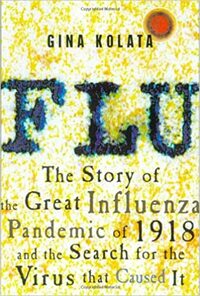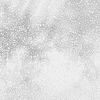Take a photo of a barcode or cover
93 reviews for:
Flu: The Story Of The Great Influenza Pandemic Of 1918 And The Search For The Virus That Caused It
Gina Kolata
93 reviews for:
Flu: The Story Of The Great Influenza Pandemic Of 1918 And The Search For The Virus That Caused It
Gina Kolata
Fascinating! It got a little slow toward the end, but then all came together. This is not just about the 1918 flu epidemic. We are taken on a journey from then to now, stopping along the way to talk about other epidemics that I didn’t know about, but which helped scientists learn more about what may have happened in 1918. It was interesting to see how the government, doctors, and scientists reacted to new findings or threats of new outbreaks. We also got a look into how scientists are able to predict, with a certain level of accuracy, what types of illnesses we will see and how dangerous/rampant they will be. The author also touched on the dilemma (a few decades ago) of whether to push a vaccine out to the general public or keep it until they had more information about the disease they were seeing. Doctors and scientists had been working on it and then they started seeing cases. It wasn’t enough to justify a panic, but they also did not want to sit on a bunch of vaccines and risk it being too late to save lives if they waited too long. I am not doing justice at all the this struggle or the details in the book. It’s late. I’m tired. But I’m trying to make the point that I learned a lot which helped me see why things are being done the way they are right now, with the novel corona virus. This context explains all the “gotcha” questions nay sayers and conspiracy theorists bring up to try to prove this is planned or a political tool or whatever craziness they came up with today.
Seemed like an appropriate read for a COVID-19 lock-down activity. The first half is much more interesting than the second but mostly because the second half is also INFURIATING because of what feels like a women-in-science discriminatory issue. The author does not take that stand at all - in fact she almost defends the other scientist who is acting "professionally" but c'mon - you read it and tell me there isn't a hint of derision...and then there's factual disappointment. So not as fun to read as the stuff about earlier infections and groundwork.
Of course there's a lot of follow-up needed on my part. The book was published 1999 and even the added epilogue in this edition is 2005. Guess I'll be able to keep busy for awhile longer.
Of course there's a lot of follow-up needed on my part. The book was published 1999 and even the added epilogue in this edition is 2005. Guess I'll be able to keep busy for awhile longer.
informative
medium-paced
informative
slow-paced
challenging
dark
informative
sad
tense
medium-paced
Did not finish.
If you're looking for a book about what it was like to experience the 1918 flu pandemic, this is not the book you want. The title of this book should be The Search for the Virus That Caused the Great Influenza Pandemic of 1918. It starts off with a little bit about the actual pandemic, and the rest of the book is long detailed histories of all the doctors and researchers who tried to figure out how the virus worked, where it came from, and if it had somehow survived for decades in the bodies of those who died from it. There's also quite a lot of discussion of other pandemics of the 20th century, and the efforts to discover if those viruses were somehow "descendants" of that 1918 strain.
This is the third book I have started and abandoned in my quest to find a book that provides a narrative of what it was like to actually live through the 1918 pandemic. Onward!
If you're looking for a book about what it was like to experience the 1918 flu pandemic, this is not the book you want. The title of this book should be The Search for the Virus That Caused the Great Influenza Pandemic of 1918. It starts off with a little bit about the actual pandemic, and the rest of the book is long detailed histories of all the doctors and researchers who tried to figure out how the virus worked, where it came from, and if it had somehow survived for decades in the bodies of those who died from it. There's also quite a lot of discussion of other pandemics of the 20th century, and the efforts to discover if those viruses were somehow "descendants" of that 1918 strain.
This is the third book I have started and abandoned in my quest to find a book that provides a narrative of what it was like to actually live through the 1918 pandemic. Onward!
My father, who is slightly more paranoid than I am, recommended this book. I bought it and did the read/listen thing as I am usually doing these days now that I am back commuting for a living. Again, the books seemed good but I had a hard time finishing it as the reader was not ideal. I believe it would have received a whole star more had another reader been performing it.
Now, the topic was super cool and I love the "Hot Zone" style (though I attribute this to "The Coming Plague" actually. It is really interesting how media and history have suppressed or ignored biological plagues. Then again, I am a total nerd for how some choices humans make result in completely unpredictable, often global, tragedy. And if you are too - this book is good for the facts... and look at Connie Willis or Mary Doria Russell for the fiction.
Now, the topic was super cool and I love the "Hot Zone" style (though I attribute this to "The Coming Plague" actually. It is really interesting how media and history have suppressed or ignored biological plagues. Then again, I am a total nerd for how some choices humans make result in completely unpredictable, often global, tragedy. And if you are too - this book is good for the facts... and look at Connie Willis or Mary Doria Russell for the fiction.
This book is fascinating as well as sobering in light of the current situation with COVID-19. Reading about the scientific processes for isolating and studying flu viruses in order to better understand the mechanisms of infection and the factors that make one virus fairly innocuous and another a deadly killer taught me some things in regard to immunology and infectious processes.
Of note is the ways in which flu viruses in animals raised for food—specifically poultry and pigs—is a veritable powder keg of infection waiting to make the jump from animals to humans. After reading this book I am fairly confident that scientists will be able to develop a vaccine for COVID-19. The question is: How long will it take and how successful will the virus be in mutating in order to survive?
One very minor quibble, because I’m a picky pedant: I would expect a science writer to know that ferrets are not rodents.
Of note is the ways in which flu viruses in animals raised for food—specifically poultry and pigs—is a veritable powder keg of infection waiting to make the jump from animals to humans. After reading this book I am fairly confident that scientists will be able to develop a vaccine for COVID-19. The question is: How long will it take and how successful will the virus be in mutating in order to survive?
One very minor quibble, because I’m a picky pedant: I would expect a science writer to know that ferrets are not rodents.
Fascinating and frightening, but worth reading even with trepidation.
The last lines of the book, written in 1998, will haunt me:
"It is hard to be complacent. Would a new killer flu look just like the 1918 flu? Or was that virus more of an example of what could happen if a flu virus was perfectly made to be a deadly foe? Will the next terrible influenza virus be a new strain that is, in its own way, ideally made to kill? Jeffrey Taubenberger, for one, thinks we cannot predict what the next flu virus will look like. The only hope we have is vigilent surveillance, keeping a careful eye out for the rough beast whose hour has come at last."
The last lines of the book, written in 1998, will haunt me:
"It is hard to be complacent. Would a new killer flu look just like the 1918 flu? Or was that virus more of an example of what could happen if a flu virus was perfectly made to be a deadly foe? Will the next terrible influenza virus be a new strain that is, in its own way, ideally made to kill? Jeffrey Taubenberger, for one, thinks we cannot predict what the next flu virus will look like. The only hope we have is vigilent surveillance, keeping a careful eye out for the rough beast whose hour has come at last."


